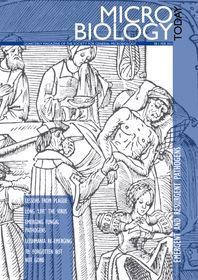Emergent & resurgent pathogens
01 February 2011 publication
The lead articles of the February 2011 issue of Microbiology Today are on lessons from plague; long 'live' the virus; emerging fungal pathogens; leishmania re-emerging; and TB: forgotten but not gone.
The power of hindsight: lessons from plague – Petra Oyston (p. 14)
Since ancient times, Yersinia pestis has wreaked havoc on the human population. Petra Oyston asks what can the transmission and evolution of this unusual pathogen teach us about how we might prepare for future emergent pathogens?
The virus is ‘dead’. Long ‘live’ the virus! – Paul Duprex & Elke Mühlberger (p. 20)
How do we face up to the global challenge of emerging viral infections? With a solid grasp of the historical perspective and armed with the latest genomic toolkit, we can now evaluate the relative merits of eradication, vaccination and chemotherapy as Paul Duprex and Elke Mühlberger explain.
Emerging fungal pathogens – Ken Haynes (p. 26)
As the number of immunocompromised individuals grows, fungal pathogens are becoming ever more important. Ken Haynes discusses how functional genomics technologies are helping to combat these less than well known eukaryotic adversaries.
Leishmania as a re-emerging pathogen – Owain Millington (p. 30)
Leishmaniasis has been recognized since ancient times and, with at least 50,000 deaths a year due to this parasitic infection, it is certainly of current importance as highlighted by Owain Millington. But is there any evidence to suggest that it can be considered as a re-emerging disease?
Tuberculosis: forgotten but not gone – Stephen Gillespie (p. 34)
UK scientists had an important role to play in the development of the first antibiotics for the treatment of tuberculosis in the mid-20th century. As we enter the second decade of the 21st century, the world is now confronted with the appearance of extremely drug-resistant strains. Stephen Gillespie asks what are UK scientists doing this time to help combat this serious threat?
How the mushroom got its spots and other stories – Sue Assinder (p. 38)
Sue Assinder has based this article on her SGM Peter Wildy Prize Lecture, delivere at the SGM Autumn 2010 Conference in Nottingham on 8 September.
Schoolzone (p. 42)
Schoolzone highlights two forthcoming resources from SGM: a series of exciting microbiology laboratory practical exercises aimed at KS3, GCSE and A level students, and a new fact file about cholera.
Gradline (p. 44)
Karen McGregor offers some sound advice and insight about working abroad based on her own experiences.
Outreach (p. 50)
Vicki Symington and Jo Verran present their views of the 2010 Manchester Science Festival.
Public Affairs (p. 53)
SGM has been spreading the word about microbiology at two major events for parliamentarians – Science and the Parliament in Scotland and our own Microbiology Awareness Campaign Climate Change event at the House of Lords – as Dariel Burdass reports.
Going Public (p. 58)
A grant from the SGM Education Development Fund helped Gareth Wyn Griffith and his colleagues from the University of Aberystwyth to organize a display about fungi at one of Europe’s largest youth festivals – the Urdd Eisteddfod – in Wales last summer.
Letters (p. 60)
The article by Pushpa Bhargava about Bt-Brinjal in the Augsut 2010 issue of MT has stimulated some debate.
Comment: NDM-1 superbug: harbinger or hype? (p. 68)
August 2010 saw a spate of ‘superbug’ articles in the UK press, prompted by the NDM-1 beta-lactamase, a resistance mechanism linked to India and Pakistan. David Livermore discusses how much of this was just hype.

